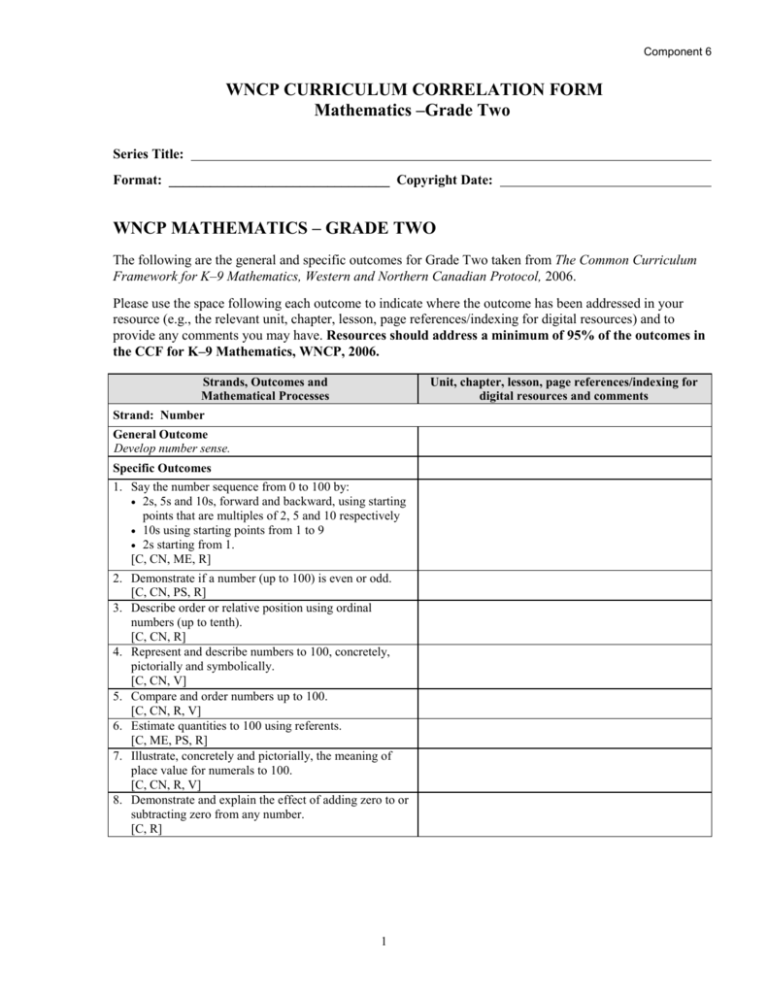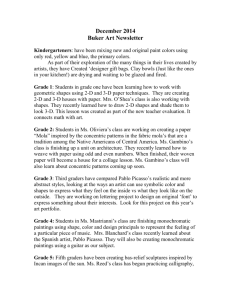Grade 2
advertisement

Component 6 WNCP CURRICULUM CORRELATION FORM Mathematics –Grade Two Series Title: Format: ________________________________ Copyright Date: WNCP MATHEMATICS – GRADE TWO The following are the general and specific outcomes for Grade Two taken from The Common Curriculum Framework for K–9 Mathematics, Western and Northern Canadian Protocol, 2006. Please use the space following each outcome to indicate where the outcome has been addressed in your resource (e.g., the relevant unit, chapter, lesson, page references/indexing for digital resources) and to provide any comments you may have. Resources should address a minimum of 95% of the outcomes in the CCF for K–9 Mathematics, WNCP, 2006. Strands, Outcomes and Mathematical Processes Unit, chapter, lesson, page references/indexing for digital resources and comments Strand: Number General Outcome Develop number sense. Specific Outcomes 1. Say the number sequence from 0 to 100 by: 2s, 5s and 10s, forward and backward, using starting points that are multiples of 2, 5 and 10 respectively 10s using starting points from 1 to 9 2s starting from 1. [C, CN, ME, R] 2. Demonstrate if a number (up to 100) is even or odd. [C, CN, PS, R] 3. Describe order or relative position using ordinal numbers (up to tenth). [C, CN, R] 4. Represent and describe numbers to 100, concretely, pictorially and symbolically. [C, CN, V] 5. Compare and order numbers up to 100. [C, CN, R, V] 6. Estimate quantities to 100 using referents. [C, ME, PS, R] 7. Illustrate, concretely and pictorially, the meaning of place value for numerals to 100. [C, CN, R, V] 8. Demonstrate and explain the effect of adding zero to or subtracting zero from any number. [C, R] 1 Component 6 WNCP Mathematics – Grade Two (continued) Strands, Outcomes and Unit, chapter, lesson, page references/indexing for Mathematical Processes digital resources and comments 9. Demonstrate an understanding of addition (limited to 1 and 2-digit numerals) with answers to 100 and the corresponding subtraction by: using personal strategies for adding and subtracting with and without the support of manipulatives creating and solving problems that involve addition and subtraction explaining that the order in which numbers are added does not affect the sum explaining that the order in which numbers are subtracted may affect the difference. [C, CN, ME, PS, R, V] 10. Apply mental mathematics strategies, such as: using doubles making 10 one more, one less two more, two less addition for subtraction to determine basic addition facts to 18 and related subtraction facts. [C, CN, ME, R, V] Strand: Patterns and Relations (Patterns) General Outcome Use patterns to describe the world and solve problems. Specific Outcomes 1. Demonstrate an understanding of repeating patterns (three to five elements) by: describing extending comparing creating patterns using manipulatives, diagrams, sounds and actions. [C, CN, PS, R, V] 2. Demonstrate an understanding of increasing patterns by: describing reproducing extending creating patterns using manipulatives, diagrams, sounds and actions (numbers to 100). [C, CN, PS, R, V] Strand: Patterns and Relations (Variables and Equations) General Outcome Represent algebraic expressions in multiple ways. Specific Outcomes 3. Demonstrate and explain the meaning of equality and inequality by using manipulatives and diagrams (0 to 100). [C, CN, R, V] 4. Record equalities and inequalities symbolically using the equal symbol or the not equal symbol. [C, CN, R, V] 2 Component 6 WNCP Mathematics – Grade Two (continued) Strands, Outcomes and Mathematical Processes Unit, chapter, lesson, page references/indexing for digital resources and comments Strand: Shape and Space (Measurement) General Outcome Use direct or indirect measurement to solve problems. Specific Outcomes 1. Relate the number of days to a week and the number of months to a year in a problem-solving context. [C, CN, PS, R] 2. Relate the size of a unit of measure to the number of units (limited to non-standard units) used to measure length and mass (weight). [C, CN, ME, R, V] 3. Compare and order objects by length, height, distance around and mass (weight) using non-standard units, and make statements of comparison. [C, CN, ME, R, V] 4. Measure length to the nearest non-standard unit by: using multiple copies of a unit using a single copy of a unit (iteration process). [C, ME, R, V] 5. Demonstrate that changing the orientation of an object does not alter the measurements of its attributes. [C, R, V] Strand: Shape and Space (3-D Objects and 2-D Shapes) General Outcome Describe the characteristics of 3-D objects and 2-D shapes, and analyze the relationships among them. Specific Outcomes 6. Sort 2-D shapes and 3-D objects using two attributes, and explain the sorting rule. [C, CN, R, V] 7. Describe, compare and construct 3-D objects, including: cubes spheres cones cylinders pyramids. [C, CN, R, V] 8. Describe, compare and construct 2-D shapes, including: triangles squares rectangles circles. [C, CN, R, V] 9. Identify 2-D shapes as parts of 3-D objects in the environment. [C, CN, R, V] 3 Component 6 WNCP Mathematics – Grade Two (continued) Strands, Outcomes and Mathematical Processes Unit, chapter, lesson, page references/indexing for digital resources and comments Strand: Statistics and Probability (Data Analysis) General Outcome Collect, display and analyze data to solve problems. Specific Outcomes 1. Gather and record data about self and others to answer questions. [C, CN, PS, V] 2. Construct and interpret concrete graphs and pictographs to solve problems. [C, CN, PS, R, V] 4







